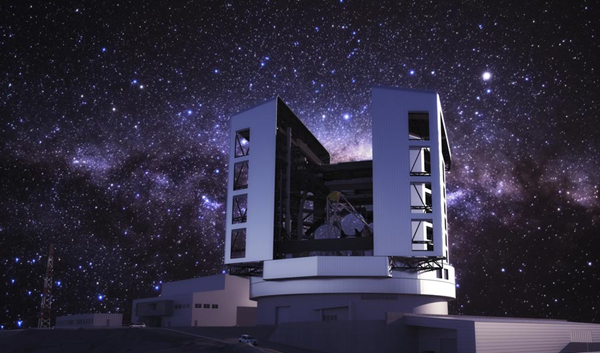At around 13 stories tall, and weighing around 14 million pounds, including the supporting structure, the GMT will be part of a new generation of “extremely large telescopes” that astronomers believe will bestow new insights into the unsolved mysteries of the universe. Constructing such a behemoth is a feat of engineering. This month, workers began casting the sixth of the seven enormous mirrors that will be arrayed in a flower shape to form the telescope’s primary light-gathering surface.
Each mirror takes four years to make. First, engineers and technicians build a honeycomb-shaped mold and fill it with 20 tons of extremely pure borosilicate glass from Japan. The honeycomb structure makes the mirror relatively lightweight given its enormous size: nearly 28 feet across. Next, a furnace heats the glass to above 2,000 degrees Fahrenheit to make it flow like honey. The furnace spins so that as the glass melts, it moves up the sides of the mold to form a curved surface. Carefully cooling the glass back to room temperature takes months.
After the mirror is cast, it must be ground and polished in a years-long process until it deviates on average by less than one-millionth of an inch from its intended shape. To achieve this extreme accuracy, researchers had to invent new polishing tools and new methods of measuring the mirror’s shape.
“None of us have a very good feel for what a millionth of an inch is, myself included,” said Buddy Martin, a project scientist at the Richard F. Caris Mirror Lab at the University of Arizona where the mirrors are made, during a virtual press conference to celebrate the sixth mirror casting. “I like to think of it as, if the mirror were expanded to the size of North America — 3,500 miles in diameter — then the average hill would be 2/3 of an inch tall and the average valley 2/3 of an inch deep. That’s how smooth this mirror has to be for it to make the sharpest images that nature will allow.”
In addition to its large primary mirrors, the GMT telescope design includes smaller secondary mirrors that can adjust their shape 1,000 times per second to counteract the “twinkle” that turbulent air in the atmosphere imparts to the light from the stars.
“The leap in sensitivity and resolution that we’re going to make with GMT will revolutionize our understanding of all areas of astronomy, from the formation and evolution of objects we can see, like planets, stars, black holes and galaxies, to cosmology and the things we can’t directly see, like the nature of dark matter and dark energy,” said Rebecca Bernstein, the lead project scientist at GMT, during the press conference.
Construction has already begun at the Las Campanas Observatory site that the telescope will call home. Current plans are for the first four primary mirrors to be shipped to Chile in the late 2020s, where they will be coated with an extremely thin layer of reflective aluminum. The telescope should see “first light” with these first four mirrors before the end of the decade and should have all seven primary mirrors in place in the early 2030s.
This story was originally published by Inside Science. Click here to read the original.










